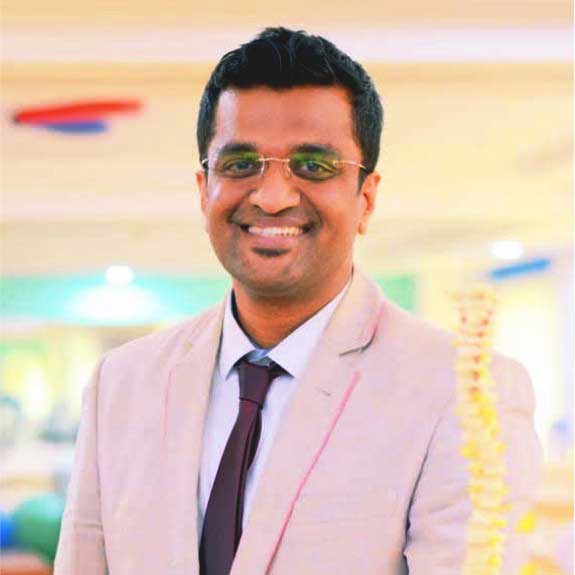Aiding Convalescence

As technology continues to transform healthcare, the field of physical rehabilitation is experiencing a surge of innovation. From immersive virtual reality therapies to wearable devices tracking real-time progress, innovative interventions are redefining recovery pathways. Yet, the pressing need for standardised care and quality assurance becomes increasingly apparent..
By Dr Saril VS (PT)
The physical rehabilitation market, globally, is experiencing significant growth due to advancements in technology. The latest trends include the use of virtual reality and robotics to enhance therapy sessions, as well as the development of wearable devices that can track and analyse patient movements in real-time. These innovations are revolutionising the way patients recover from injuries and regain their mobility.
Rehabilitation medicine’s conventional approach has several limitations. Firstly, it heavily relies on traditional methods that may not always be evidence-based or aligned with the latest advancements in the field. Secondly, there is a lack of standardisation and quality assurance in rehabilitation services delivery, leading to variations in patient outcomes. Lastly, the conventional approach often neglects the importance of a multidisciplinary and holistic approach to rehabilitation, which can limit treatment effectiveness and hinder patients’ overall recovery.
Poor quality in rehabilitation services can have significant negative impacts on patients. It can lead to suboptimal outcomes, prolonged recovery times, and increased risk of complications. Patients may experience inadequate pain management, improper functional assessments, and inappropriate treatment interventions, all of which can hinder their progress and impede their overall well-being. Additionally, poor quality in rehabilitation medicine can result in decreased patient satisfaction and trust in the healthcare system, further exacerbating the negative effects on patient care.

To address poor quality in rehabilitation medicine, it is crucial to implement robust quality improvement initiatives. This can involve establishing standardised protocols and guidelines for patient care, implementing regular performance assessments and audits, and providing ongoing training and education for rehabilitation professionals. Additionally, fostering a culture of continuous improvement and accountability within healthcare organisations can help drive positive change and ultimately improve the quality of care provided to patients in rehabilitation medicine.
Quality-focused rehabilitation services prioritise evidence-based practices, person-centred care, and interdisciplinary collaboration to provide comprehensive and individualised treatment plans. Person-centred care in rehabilitation medicine ensures that the individual’s goals, preferences, and values are at the forefront of their treatment plan. This approach promotes shared decision-making and empowers patients to actively participate in their own recovery. Person-centred care can be implemented in rehabilitation interventions by involving patients in goal-setting and treatment planning, encouraging their active participation in therapy sessions, and regularly seeking feedback to assess their satisfaction and progress. For example, therapists can collaborate with patients to develop personalised exercise programs that align with their preferences and priorities. Additionally, incorporating shared decision-making in the selection of treatment options, such as assistive devices or adaptive equipment, ensures that patients’ individual needs and preferences are considered.
Safety in rehabilitation services can be addressed by implementing comprehensive safety protocols and guidelines that address potential risks and hazards in the rehabilitation setting. This can include measures such as ensuring proper patient identification, medication reconciliation, infection control practices, emergency preparedness and fall prevention strategies. Additionally, regular staff training and education on safety practices can increase awareness and reduce errors. Another strategy is to promote a culture of open communication and reporting, where staffs feel comfortable reporting safety concerns or near-miss incidents. This allows for the timely identification and mitigation of potential safety issues. Finally, ongoing monitoring and evaluation of safety practices, along with regular audits and feedback, can help identify areas for improvement and ensure continuous safety enhancements in rehabilitation medicine.
Quality accreditation in rehabilitation plays a crucial role in improving patient outcomes. It provides a structured framework for healthcare organisations to assess and enhance the quality of their services. By achieving accreditation, rehabilitation facilities demonstrate their commitment to delivering high-quality care and meeting rigorous standards. This not only instils confidence in patients but also ensures that they receive evidence-based treatments and interventions that are proven to be effective. Additionally, quality accreditation promotes a culture of continuous improvement, encouraging healthcare professionals to stay up-to-date with the latest advancements and best practices in rehabilitation medicine.
A global rehabilitation quality forum can address global needs by promoting systematisation and consistency in patient care practices across different regions. By bringing together experts from various disciplines and institutions, a quality forum can facilitate the dissemination of evidence-based guidelines, promote innovation in rehabilitation medicine, and drive continuous improvement in patient care. It can serve as a platform for sharing best practices, evidence-based guidelines, and innovative approaches to rehabilitation, ultimately improving the quality of care provided to patients worldwide. Additionally, a quality forum can facilitate collaboration and networking among healthcare professionals, fostering international partnerships and knowledge exchange that can contribute to advancements in the global rehabilitation landscape.

By leveraging virtual platforms and teleconferencing tools, healthcare professionals from different regions can easily connect and participate in discussions, sharing best practices and exchanging knowledge. This will break down geographical barriers and allow for a more inclusive and diverse forum that can drive continuous improvement in patient care on a global scale.
In line with this innovative vision, the Consortium of Healthcare Accredited Organisations (CAHO) is launching a global Rehab Quality Forum as part of CAHOCON 2024. In the best interest of patients and caregivers, this is indeed the imperative of the hour. Through this forum, CAHO is driving positive change and improving rehabilitation services standards worldwide. CAHO encourages all stakeholders to join the forum and work together to ensure quality rehabilitation services by committing to making a meaningful impact in the field of rehabilitation. By working together, stakeholders can ensure that rehabilitation services are of the highest quality and that patients and their families receive the best possible care.
Embracing quality as a process allows for ongoing evaluation and refinement, leading to higher customer satisfaction, increased efficiency, and a competitive advantage in the marketplace. It also fosters a culture of excellence and innovation, driving long-term success and growth. After all, quality is a journey, not a destination!.
(The author is Asst. General Manager-Quality & BD, Sakra Institute of Rehabilitation Sciences, Sakra World Hospital, Bangalore, a joint venture of SECOM & Toyota Tsusho, Japan)

